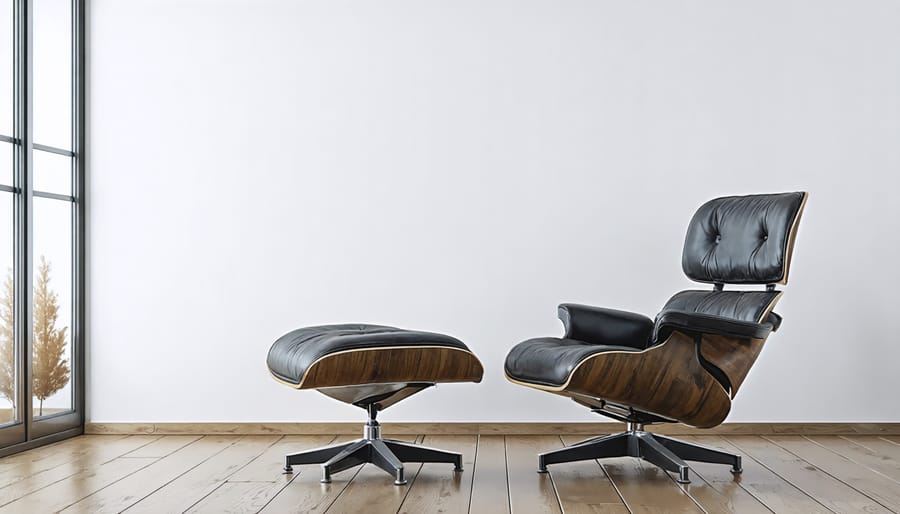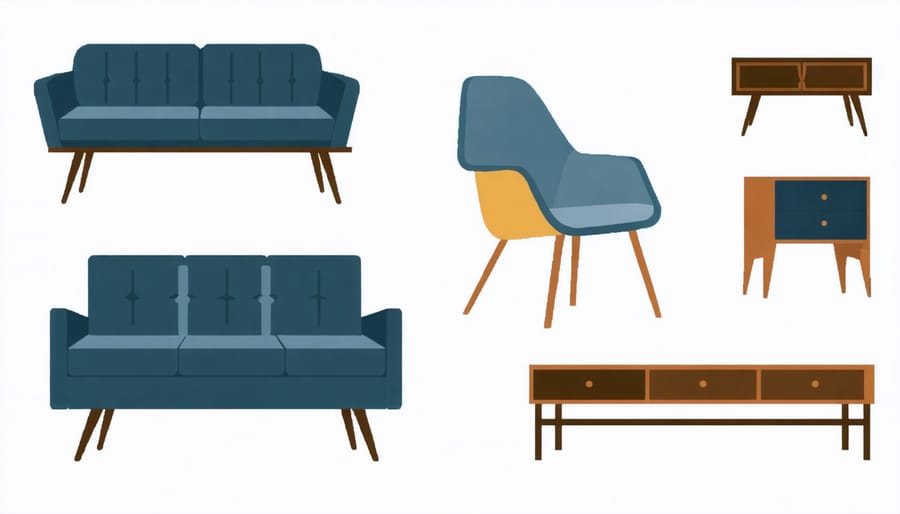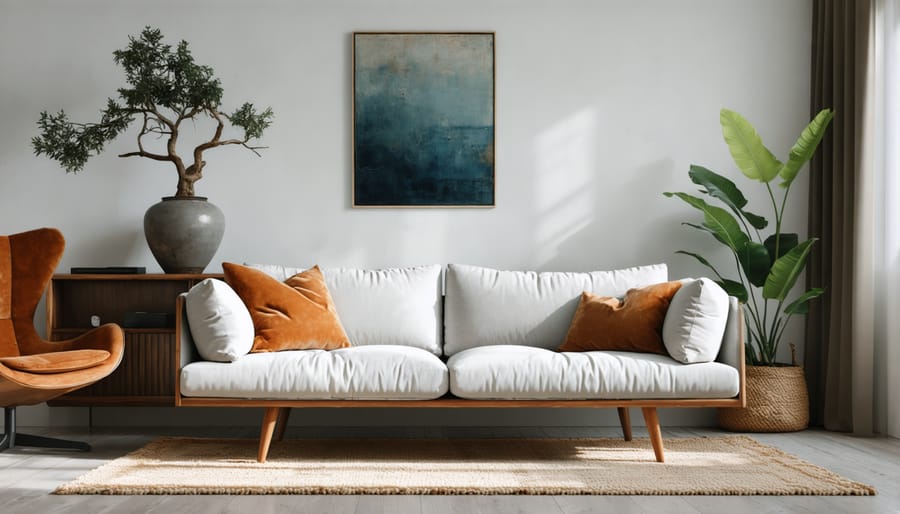Mid-century modern design captured the optimism and innovation of post-war America, transforming everyday spaces into artistic statements of simplicity and function. Born between the 1940s and 1960s, this revolutionary design movement continues to captivate homeowners and designers today with its clean lines, organic curves, and seamless blend of natural and manufactured materials.
From the iconic Eames lounge chair to the timeless sunburst mirrors, mid-century modern pieces tell a story of cultural transformation, when America’s suburban dream met European modernism to create something entirely new. This era’s emphasis on bringing the outdoors in through large windows, open floor plans, and natural materials wasn’t just about aesthetics – it represented a fundamental shift in how people viewed their living spaces.
Now experiencing a remarkable revival, mid-century modern design speaks to contemporary desires for authenticity, sustainability, and purposeful living. Its enduring appeal lies not just in its distinctive look, but in its core principles: the belief that good design should be accessible to all, that form should follow function, and that simplicity creates beauty. Whether you’re a dedicated enthusiast or simply curious about incorporating these timeless elements into your home, understanding mid-century modern design opens up a world of sophisticated yet approachable interior possibilities.
The Golden Age of Mid-Century Modern (1945-1969)
Post-War Design Revolution
The post-war era ushered in unprecedented social and technological changes that dramatically shaped mid-century modern design. As soldiers returned home and the baby boom began, there was an urgent need for affordable, functional housing and furniture. This demand, coupled with wartime technological advances in materials like plywood, plastic, and aluminum, gave designers exciting new possibilities to explore.
The optimism of the post-war period influenced designers to create forward-looking pieces that embraced the future. New manufacturing techniques made it possible to mass-produce furniture that was both beautiful and accessible to the average American family. Materials previously reserved for military use, such as molded plywood and fiberglass, found their way into everyday homes through innovative chairs, tables, and storage solutions.
The space race and atomic age also left their mark on mid-century design, inspiring organic, space-age shapes and starburst patterns. Television’s growing popularity changed how families used their living spaces, leading to more open floor plans and multifunctional furniture. This period saw the rise of indoor-outdoor living, with large windows and sliding glass doors bringing nature inside, reflecting the era’s newfound prosperity and leisure time.
The design revolution wasn’t just about aesthetics – it represented a fundamental shift in how Americans lived and interacted with their homes.
Iconic Designers and Their Influence
The mid-century modern movement was shaped by visionary designers whose influence continues to inspire today’s interiors. Charles and Ray Eames revolutionized furniture design with their iconic Eames Lounge Chair and innovative use of molded plywood. Their pieces perfectly balanced comfort with sleek aesthetics, making design accessible to the average American home.
Florence Knoll transformed office spaces with her minimalist approach, introducing clean lines and functional beauty to corporate America. Her furniture pieces, particularly the Knoll sofa, remain coveted classics. George Nelson, known for his Marshmallow Sofa and Bubble Lamps, brought playful elements to serious design, proving that functionality could coexist with whimsy.
Danish designer Arne Jacobsen created the instantly recognizable Egg Chair and Swan Chair, demonstrating how organic shapes could be incorporated into modern design. Meanwhile, Eero Saarinen’s Tulip Chair and Table series eliminated the “slum of legs” in dining rooms, creating a revolutionary pedestal-based furniture style.
These pioneers shared a common vision: creating beautiful, functional pieces that would stand the test of time. Their designs weren’t just furniture; they were statements about how modern life could be both practical and sophisticated.

Core Elements of Mid-Century Modern Style
Clean Lines and Organic Forms
One of the most striking features of mid-century modern design is its perfect balance between sleek geometry and natural curves. Picture clean, straight lines that suddenly give way to gentle, organic shapes – much like nature itself. Furniture pieces often feature slim, angled legs that seem to defy gravity, while seat backs and tabletops embrace smooth, curved edges that feel inviting and comfortable.
This design approach wasn’t just about looks; it was a rebellion against the ornate styles of previous eras. Designers stripped away unnecessary decoration, focusing instead on honest, simple forms that celebrated both function and beauty. You’ll notice this in iconic pieces like the egg chair, with its perfectly curved shell, or in streamlined credenzas that appear to float above their tapered legs.
Materials play a crucial role too, with natural wood grains adding warmth to geometric shapes, and molded plastics taking on sculptural forms. These elements create a visual language that’s both sophisticated and approachable, making mid-century modern pieces as relevant today as they were 70 years ago.

Material Innovation
The mid-century modern era revolutionized interior design through its innovative use of materials, many of which were new to the residential market at the time. Plywood, previously considered purely utilitarian, became a star player in furniture design thanks to pioneers like Charles and Ray Eames, who developed techniques to mold it into elegant curved forms.
Plastics made their grand entrance into home decor during this period, with designers embracing materials like fiberglass, Lucite, and polyethylene to create lightweight, sculptural pieces that were both functional and artistic. These synthetic materials allowed for bold, fluid shapes that would have been impossible to achieve with traditional materials.
Metal, particularly aluminum and steel, took on new life in residential settings. Chrome-plated finishes became increasingly popular, adding gleam to furniture legs, lamp bases, and decorative accessories. The combination of these industrial materials with organic elements like wood created the signature contrast that defines mid-century modern style.
Glass played a crucial role too, with large windows and sliding doors becoming architectural staples. Designers often paired glass with natural stone like marble and travertine, creating sophisticated surfaces that added texture and visual interest to spaces while maintaining the era’s clean lines.
Color Palettes and Patterns
The mid-century modern era embraced bold, nature-inspired color schemes that still feel fresh and relevant today. Rich earthy tones like burnt orange, deep brown, and olive green were often paired with muted neutrals to create dynamic spaces. These colors drew inspiration from the natural world while maintaining a sophisticated urban edge.
Geometric patterns played a crucial role in mid-century design, featuring clean lines, abstract shapes, and organic forms. Starbursts, boomerangs, and atomic patterns were particularly popular, reflecting the era’s fascination with space exploration and scientific progress. These motifs appeared on everything from wallpaper to textiles and decorative accessories.
The palette wasn’t limited to earth tones, though. Vibrant pops of mustard yellow, turquoise, and coral were frequently used as accent colors to energize spaces. These brighter hues were often introduced through artwork, throw pillows, or statement furniture pieces. Texture also played a significant role, with materials like teak wood, brushed brass, and woven fabrics adding depth and visual interest to the overall design scheme.
Today’s interpretation of mid-century color palettes often includes updated versions of these classic combinations, making them perfect for modern homes while maintaining their retro charm.
Modern Revival: Why Mid-Century is Back
Contemporary Appeal
Mid-century modern design continues to captivate homeowners and interior design enthusiasts for compelling reasons. Its clean lines and functional approach perfectly align with contemporary lifestyles, offering a timeless aesthetic that bridges the gap between past and present. Modern homeowners particularly appreciate how these designs can make spaces feel both sophisticated and livable.
The style’s emphasis on simplicity and functionality resonates strongly with today’s minimalist movement and desire for clutter-free living. Large windows and open floor plans characteristic of mid-century design answer the current demand for bright, airy spaces that promote wellbeing and connection with nature. Additionally, the furniture’s modest scale works exceptionally well in urban apartments and smaller modern homes.
Another draw is the style’s versatility. Mid-century pieces can easily mix with contemporary furnishings, creating personalized spaces that don’t feel like museum exhibits. The combination of natural materials like wood with modern materials such as metal and glass appeals to those seeking sustainable yet stylish solutions.
Social media and popular culture have also fueled this revival, with platforms like Pinterest and Instagram showcasing how mid-century modern elements can transform ordinary spaces into extraordinary ones. The style’s warm, organic approach to modernism offers a welcome alternative to the stark, industrial aesthetic that dominated early 2000s design, making it particularly appealing to millennials and young professionals seeking character in their living spaces.
Adapting Mid-Century for Modern Living
Incorporating mid-century modern design into contemporary living spaces doesn’t mean turning your home into a museum. The key is finding the right balance between vintage charm and modern functionality to create a cozy home that reflects both eras beautifully.
Start with signature pieces that define the style – perhaps a sleek sideboard or an iconic chair with clean lines. Mix these with contemporary items that complement rather than compete. Consider introducing warm wood tones through furniture or accent pieces, paired with current materials like glass and metal for a fresh take on the classic look.
Color plays a crucial role in modernizing mid-century style. While you can embrace the traditional palette of oranges, teals, and mustard yellows, try using these as accents against neutral backgrounds for a more contemporary feel. Geometric patterns and abstract art pieces can add authentic mid-century touches without overwhelming the space.
Don’t forget functionality – update classic pieces with modern conveniences. A vintage-style media console can be modified to accommodate today’s electronics, while maintaining its original aesthetic. Layer in current textiles and lighting fixtures that echo mid-century shapes but feature updated materials and technology.
Remember, the goal isn’t to recreate a 1950s home but to capture the spirit of mid-century design in a way that works for modern living. Focus on quality over quantity, and let each piece tell its own story within your contemporary space.
Getting the Look: Practical Tips
Key Pieces and Where to Find Them
Finding authentic mid-century modern pieces doesn’t have to be a treasure hunt. For original pieces, start with estate sales and reputable antique dealers, where you can often discover genuine items from the 1950s and 60s. Online marketplaces like 1stDibs and Chairish specialize in authenticated vintage furniture, though prices can be steep.
For more budget-friendly options, consider well-made reproductions from retailers like West Elm, Article, and CB2. These stores offer pieces that capture the essence of mid-century design at more accessible price points. Thrift stores and flea markets can also yield unexpected finds, particularly for smaller decorative items and lighting fixtures.
Key pieces to look for include:
– The iconic Eames lounge chair (original from Herman Miller, reproductions widely available)
– Noguchi coffee tables (authentic pieces through Herman Miller, quality reproductions through various retailers)
– Saarinen tulip chairs and tables (both vintage and new productions available)
– Danish teak sideboards (often found at vintage furniture stores)
– Starburst clocks and sunburst mirrors (both vintage and contemporary versions)
When shopping, pay attention to materials and craftsmanship. Authentic pieces typically feature solid woods, high-quality metals, and expert joinery. For reproductions, look for similar quality markers and read reviews from other buyers. Remember, mixing authentic vintage pieces with quality modern reproductions can create a stylish and budget-conscious mid-century look.
Mixing Old and New
Creating a harmonious blend of mid-century modern and contemporary pieces is an art that anyone can master. The key to successful mixing vintage and contemporary pieces lies in finding the right balance and creating intentional connections between old and new.
Start by selecting a few statement mid-century pieces, such as an iconic Eames lounge chair or a sleek teak sideboard, to serve as anchors in your space. Then, complement these classics with modern elements that share similar lines or materials. For instance, pair a vintage walnut dining table with contemporary chairs in complementary materials like molded plastic or powder-coated steel.
Color plays a crucial role in bridging the decades. Use a consistent color palette throughout your space, incorporating both vintage and modern pieces that share similar hues. Mid-century oranges and teals can work beautifully with today’s trending earth tones and metallic accents.
Don’t forget about scale and proportion. Mix larger vintage pieces with smaller contemporary accessories, or vice versa. Add modern lighting fixtures to illuminate vintage furniture, or display current art pieces above classic mid-century storage units. Remember that negative space is just as important as the pieces themselves – allow room for each element to breathe and make its own statement.
The goal isn’t to create a museum-like display but rather a livable, contemporary space that honors the timeless appeal of mid-century design while embracing modern comfort and functionality.

Mid-century modern design continues to captivate and inspire homeowners today, proving that great style truly is timeless. With its clean lines, organic forms, and perfect balance of form and function, this iconic era offers endless possibilities for contemporary living spaces. Whether you’re drawn to the warm wood tones, geometric patterns, or the seamless indoor-outdoor connection, there’s a way to incorporate these elements into your home that feels both authentic and fresh.
Remember that embracing mid-century modern doesn’t mean turning your home into a museum. Start small with signature pieces like a classic chair or abstract art print, then gradually build your collection as you develop your personal style. Mix vintage finds with modern reproductions, and don’t be afraid to blend mid-century elements with other design styles you love.
The enduring appeal of mid-century modern lies in its ability to create spaces that are both sophisticated and livable. By understanding and appreciating the core principles of this design movement, you can create a home that honors the past while looking confidently toward the future.
